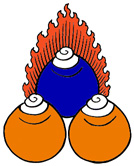| |

Studies
in
Buddhadharma
On Buddhahood or Awakening
 Contents
Contents  SiteMap
SiteMap

"Whatever is the essence of the Tathâgata,
That is the essence of the transmigrator.
The Tathâgata has no essence,
The transmigrator has no essence."
Nâgârjuna : Mûlamadhyamakakârikâ, XXII.16.
"If phenomena existed through their own
characteristics, the ontological status of the Tathâgata and his
attributes would not make any sense. But their ontological status is
completely tenable insofar as they are dependently originated and empty of
existence through their own characteristics." - Tsongkhapa
: Ocean of Reasonings, XXII.3.
"Spontaneously and without thought a Buddha, like a wish-granting
jewel, achieves the aims of beings, but does not stir from a moment from
the sphere of the final nature of phenomena." -
Hopkins, J. :
Meditation on Emptiness, p.122.
|
In the Greater Vehicle, the
Mahâyâna, both Sutric & Tantric, Buddhahood,
final liberation,
enlightenment or awakening are synonymous,
referring to the ultimate state of mind, called wisdom-mind (or
"bodhi" mind of Clear Light). Such an
exhalted mind has ultimate truth, the emptiness of all objects of
mind as its object, having totally & irreversibly ended substantial
instantiation. While a dependent arising, and thus impermanent,
Buddhahood is an uninterruptedly continual pristine wisdom-mind.
Every single Buddha has a unique dance, a perfect holistic
kinetography.
The views trying to understand Buddhahood are interpretations of the
Two Truths.
They either stress the duality of both truths or their unity. In the
latter case, there is only One Truth, namely ultimate truth and
conventional truth is rejected. In the former, both truths operate
simultaneously.
The views on ultimate truth also differ. Self-emptiness (Rangton)
posits all phenomena, Buddhahood included, are empty of self-powered
& self-settled substance, but full of otherness (relations). In the
view of other-emptiness (Shentong), this ultimate wisdom prehended
by wisdom-mind is permanent & truly
existent, i.e. subsisting and therefore substantial (a thing from
its own side).
For Shentong, self-emptiness is
annihilatory, wrongly identifying Buddhahood with nothingness. But
for Tsongkhapa, not the object of knowledge is negated (for him,
self-emptiness is not the object's emptiness of itself, as Dolpopa
claims), but only its substantial instantiation. Hence, the ultimate is
the non-affirming negative of the inherent existence of conventional
objects, not of conventional reality per se. Hence, a Buddha
knows all objects explicitly. From his own perspective, he knows
only the endless purity of emptiness, but he also directly &
simultaneously perceives all conventional phenomena as they appear to
sentient beings.
Afflictive desires obstruct
liberation,
but obstructions to omniscience prevent Buddhahood.
|
Leaving aside Shentong (and
their ontology of
Buddha-nature)
as well as Dzogchen, the
Middle Way view has different interpretations of Buddhahood. Let us
compare Tsongkhapa, and his Middle Way Gelugpas, with the Sakyapa Gorampa. While both
are committed to the view Buddhas possess unique cognitive abilities, like
knowing all objects of knowledge in then span of a single instant, they
disagree on how and in what way this knowledge is gathered. The crucial
divide involves the status of conventional, empirical truth. For Gorampa,
Buddhas operate entirely independently of this, while for Tsongkhapa,
enlightened wisdom has knowledge of both the empirical and ultimate
truths.
The issue revolves around the (a) the interpretation of non-duality and
(b) the status of ultimate truth.
For Gorampa, ultimate truth is split off from conventionality. Is is
ontologically "higher" because it does not involve deception, while
conventionality always does. Tsongkhapa agrees conventional truth is
deceptive, but accepts its validity in terms of wordly conventions.
Empirical validity is possible, despite the fact empirical statements conceal
their ultimate truth, namely the absence of substantiality.
Conventional truth presents the world as static instead of dynamical, and
for this reason it is deceptive. For Gorampa, this is reason enough to
discard conventionality per se, placing it in the category of
invalid illusions. As only ultimate truth is nondeceptive, only
ultimate truth is, in an absolute sense, "true" ! Hence, there is only One
Truth, namely ultimate truth. For Gorampa, duality, characterizing
conventionality, conceptuality & cognition is invalid.
For Tsongkhapa,
conventionality is indeed illusionary (mistaken), but valid (conventionally). So
are conceptuality and cognitive activity. Even duality is not a problem,
rather the reification of its terms is. Ultimate truth is not
"higher" or ontologically different than conventional truth, for the
ultimate exists conventionally, and not, as Gorampa states, as an absolute
object in its own ontological sphere. Tsongkhapa rejects this Platonic
idealism.
The ultimate truth is one of the two natures of each and every
phenomenon. Known by way of conventions, the deceptive but conventionally
valid empirical reality of an object appears to the worldly mind. Known by
way of ultimate analysis, the nondeceptive, ultimate truth of the same
object is realized by wisdom-mind. Coherent knowledge involves the mutual
collaboration of the
Two Truths. One has to argue against a division
between them and against a reduction of them. They involve two different types of
cognition, each with a different sphere of authority. Conventional
phenomena cannot determine the ultimate status of phenomena, nor can their
ultimate analysis in any way be authoritative for their conventional
status.
These conflicting views influence their view on Buddhahood.
First Gorampa.
All sentient beings, including Hearers, Foe Destroyers, Solitary Buddhas and Superior
Bodhisattvas are subject to varying degrees of misconceptions regarding
the Two Truths. Ordinary beings are influenced by reifying ignorance &
defilements. On the Eighth Bhûmi and below, Superior Bodhisattvas, having
experienced ultimate truth, are free from these tendencies. Mahasattvic Bodhisattvas of the Eighth to the Tenth Bhûmis
are totally free from even the subtlest latent (innate) reifying
tendencies, but are subject to nondeluded ignorance, the conditioned state
of mind predisposed by the previously existent innate conception of
inherent existence or essence. So they are not yet fully enlightened. They
are predisposed to the assumption of dualities rather than their
reification. Hence, misconceptions of dualistic appearances remain. For Gorampa,
Buddhas eliminate all duality. So "dualistic appearance" means the
conflict between the ultimate object & the ultimate subject. These Âryas
are not yet enlightened because this duality abides. Once this duality is
gone, they are Buddhas. They only know conventional objects implicitly,
namely by knowing they do not exist. How they apprehend their absolute
object or are capable of being compassionate for deluded conventionality
is not really explained.
For Tsongkhapa, duality itself is not a problem. The interaction between
cognition and the cognitive field cannot be avoided, not even in the most
evolved wisdom of Ârya Buddhas (cf. wisdom-minds apprehending emptiness).
In his view, Buddhahood involves the simultaneous prehension of the
ultimate & the conventional of every phenomena. For Tsongkhapa, the above
Mahasattvic Bodhisattvas are not yet enlightened because for them ultimate & conventional
knowledge still come about sequentially, and so they have only
alternating knowledge of the Two Truths. During meditation they known
the ultimate. In postmeditation, they apprehend the conventional. But once
they are capable of having direct knowledge of both truths
simultaneously, able to cognize empty & dependently arisen phenomena
concurrently, establishing the non-conceptual dual-union of the Two Truth,
they become Buddhas. Then, from their own perspective, only emptiness is
apprehended, while all conventionality is explicitly known as it appears
to sentient beings. So far the Gem of the Scholars of the Land of Snow.

|
|



